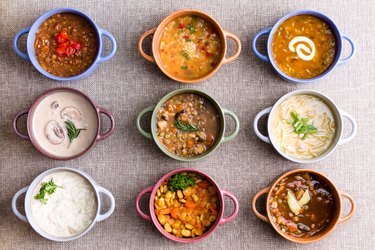
The definition of "comfort food" varies widely, but one type of cuisine seems to hold universal appeal: soup! Whether it's filled with rich ingredients or cobbled together from whatever's left in the house, soup simply feels like home. Soup also entices year-round, with varieties ranging from hearty, warming winter soups to the light, fresh palate-pleasers of midsummer. If from-scratch soups aren't already part of your repertoire, we've got your back with a guide for budding soup makers.
Part 1: Soup Basics
Video of the Day
Let's start by nailing down what we mean by "soup," as the term covers a lot of territory. The great French chef Auguste Escoffier broke soup into several categories—purées, coulis, velouté, bisques and so on—but we won't fuss over classical definitions for the purposes of this guide or dissect whether it's more accurate to call something a soup or a stew. Sure, stews are usually thicker and chunkier than soups, but lots of soups are also thick and chunky. In our guide, if it's in a bowl and it's wet, a bit sloppy and, well, "soupy," we'll call it a soup!
Video of the Day
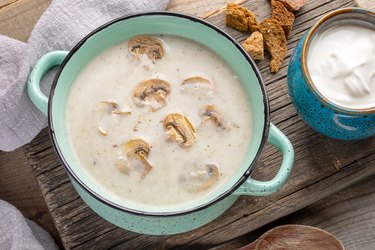
From there, we'll divide soup into two broad categories: thick and thin. Soup can be thick because it has been puréed, contains thickened broth or has additional ingredients—barley or okra, for example—that naturally thicken texture. Thin soups, on the other hand, are primarily brothy. In fact, it's often a point of pride for the cook if broth remains extra clear. In general terms, thick soups are heartier and lend themselves to cold-weather meals, but some thin soups are great in winter while some thick soups are great in summer. In our eyes, there's just one rule to keep in mind: Don't sweat the rules! Eat the soup you like when you feel like it.
Part 2: Stock, Broth & Soup Bases
Most soup recipes are complete one-pot soups in themselves. If you have all the ingredients and follow instructions closely, you'll end up with a fantastic final product. They might start with water or an alternative base liquid like clam juice, tomato juice or milk. Others might use a form of concentrated flavoring, from miso to dashi (cured tuna flakes) to something as simple as a Parmesan cheese rind.
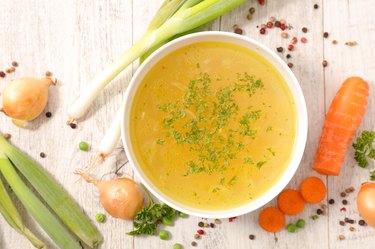
1. Store-bought broth or stock
If you want to be an improvisational soup maker who's capable of cranking out quick, tasty soup with the flair of a jazz musician, you'll want to keep stock or broth on hand. There's no shame in using store-bought broth or concentrate, especially if you don't have freezer space to store lots of stock. Besides, having store-bought ingredients available can mean the difference between making soup or not—and concentrates are typically better than powders or cubes.
Making your own stock or broth certainly broadens your options, though, so let's explore.
2. Homemade broth or stock
To make your own broth or stock, simmer a primary flavoring ingredient (usually bones and meat, unless you're making a vegetable soup) with aromatics such as garlic, onions, celery, tomatoes and a few other flavoring ingredients. The time it takes to extract flavor depends on the size of the bones: Beef stock might need to simmer for several hours, chicken stock for just a few and fish stock for only 45 minutes or so.
Aside from flavor, that simmering time melts collagen from bones and connective tissues. This is what gives well-made stock or broth a rich sensation in the mouth ("mouthfeel," in chef-speak). You can simmer it in any large pot, but a purpose-made stock pot is usually tall and relatively narrow. This creates a small surface area for evaporation, so the mixture can simmer for long stretches of time without the constant need for extra water.
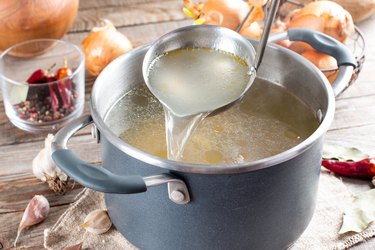
3. Broth vs. stock
What's the difference between broth and stock? Non-chefs tend to use the words interchangeably, but they're not identical. With stock, emphasis is on bones (rather than meat) and the liquid is not usually seasoned or meant to be consumed as is. Broth ("bone broth" notwithstanding) places more emphasis on meat and is fully seasoned so it can be consumed on its own and maintain a delicious taste. In short, broth is a finished product while stock is an ingredient.
How to Make a More Flavorful Stock
For a full-flavored stock, maintaining the balance of flavoring ingredients to water is important. Professional chefs use a fairly consistent ratio: For any given weight of water (pros always measure by weight), you’ll need at least half that weight in bones and a tenth of that weight in onion, celery and carrot. A half gallon weighs roughly 4 pounds, so that comes out to no less than 2 pounds of bones and meat trimmings (a bit more for a richer stock) and about 6 1/2 ounces (by weight) of vegetables. Onions should be half the total, with the rest divided evenly between carrots and celery.
The important part is the weight of bones, which provides primary flavor. You can “eyeball” aromatic vegetables, but don’t use so many that they overwhelm the primary flavor. Roast bones and veggies first, if you'd like, to give your stock a deeper color and flavor.
For faster prep and more flavorful stock, use a pressure cooker rather than a conventional stock pot. You can use either a stovetop model or one of the popular electric models, like an Instant Pot. The higher temperature of pressure cooking extracts more flavor and collagen from bones in much less time, so you’ll get a richer stock faster. That’s a win-win.
Part 3: Thick Soups
These are the kinds of hearty, comforting soups you'll turn to on a winter day to help drive that stubborn chill out of your bones. There are several types and an infinite number of variations to work from. In broad terms, though, thick soups encompass three main classifications.
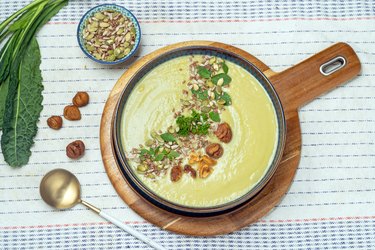
1. Puréed soups
These are some of the simplest to make. Simmer the main ingredient of your choice in a flavorful broth—chicken broth works, or vegetable broth if you want to keep it meat-free—then, once it's tender, purée soup with a standard or immersion blender. Almost any vegetable works beautifully in this kind of simple preparation: Butternut squash soup is a classic example, but leek and potato, cauliflower or broccoli works just as well. Tomato soup fits this category too, though you might not think of it as a purée. Even stringy vegetables such as asparagus or celery do well, though you'll need to press the soup through a strainer to get the stringy bits out.
Tip
If you’re working with a vegetable like broccoli or asparagus, hold back some florets or asparagus tips for garnish, then add them after you’ve pureed the rest.
Vegetables aren't the only option, of course. Legumes are also excellent for puréed soups, with split pea soup being the most well-known example. Black bean soup, lentil soup, chickpeas, even maafe, a West African peanut stew, fit this category.
Whether you opt for vegetables, legumes or both, they all make fantastic choices for a weeknight meal. You can whip up a puréed soup in just minutes with prepared broth and quick-cooking (or frozen) vegetables or leave legumes and longer-cooking root vegetables in a slow cooker all day and purée them when you get home.
2. Cream soups

Cream soups are an entirely separate class of hearty soups and are often thought of as winter-centric, though they can be enjoyed in every season. Unless you're a purist, cream soups don't necessarily have to contain actual cream. Many use milk instead, but you can also work with plant-based alt-milks or coconut cream (the thick stuff from the top of a can of coconut milk, not the sweetened kind you'd use in a piña colada). They're primarily thickened with a starch of some sort, typically flour or cornstarch, though there are special-purpose alternatives as well: Arrowroot flour won't result in an odd texture if you freeze and thaw your soup, while xanthan gum and guar gum work for gluten-free or low-carb soups. You can also simply add cream to a puréed soup, which often won't require any further thickener.
Don't overthink a cream soup. Simmer your choice of ingredients in broth or a broth-and-milk mixture, thicken and season it to taste and you're done. Restaurants the world over recoup their pennies with a "cream of whatever's in the fridge" special, and so can the home cook. Any extra veggies you have on hand will work in a creamy soup, even red peppers, lettuce or onions (lots of onions!) if that's what you've got. Cream of mushroom soup, cream of chicken, cream of broccoli or cauliflower, and—of course—chowder are all classic options.
3. Stews and hearty soups
Stews are essentially hearty soups with a broth that's thickened, much like cream soups. They're usually thickened with flour or another starch, though in some cases a starchy ingredient (potatoes, sweet potatoes, beans, peas or squash) provides natural thickening. Beef stew, Irish stew and your grandma's chicken and dumplings all fit into this category, as do many legume-centric vegetarian options from around the world—India's thousands of dhal recipes, for example.
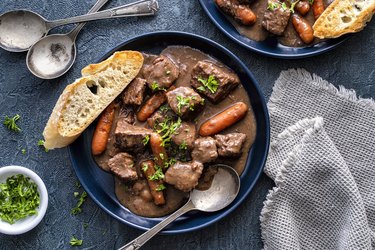
Some of the best winter soups are "broth with things in it" like summer soups, but they're still hearty because they pack so much into each bowl. A white bean soup, for example, can be a summer or winter dish depending on how well loaded it is with beans, vegetables and ham. Similarly, minestrone can be served as a summer meal, but it's packed with more than enough vegetables and pasta to make a satisfying cold-weather meal (the name literally means "big soup"). The Eastern European culinary repertoire is filled with variations on cabbage soup, while a bowl of simple Italian-style chicken broth (brodo) can become a solid meal if you add enough gnocchi or tortellini.
Many soups are also thickened with bread, a throwback to the days when soup would routinely be ladled over a chunk of stale bread—the "sop," which is actually where our word "soup" comes from—to make it more filling. The crouton in your French onion soup is a modern example. So is tortilla soup, as are gazpacho and Italian ribollita, which (though thick) are traditionally summertime soups.
Part 4: Thin Soups
Soup isn't all about cold winter nights. During the rest of the year, the whole family can enjoy thinner but equally delicious soups as light and refreshing standalone meals or as starter courses to begin the meal.
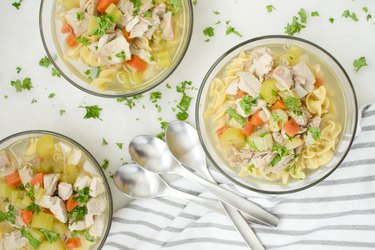
1. Broth-based soups
For many of us, the ultimate comfort classic in this style is good ol' chicken noodle soup. Depending on your ambitions and how your day's going, chicken noodle soup can be simmered the old-fashioned way through a long, lazy afternoon or hastily assembled in minutes with premade broth and the leftovers from a rotisserie chicken. The most remarkable part? Both will be good.
Thin, broth-based soups are incredibly versatile. Got some leftover turkey? Make broth from the carcass, add a handful of wild rice and veggies and you've got a beautiful (but easy) turkey and wild rice soup. Many of Asia's most-loved soups consist mainly of noodles in a bowl of broth, with flavorings and garnishes that vary by country. When you only have bits and pieces to cook with, soup creates an easy way to use them up and create a satisfying meal.
2. Non-broth thin soups
In the absence of broth (or as a complement to it), you can turn to things like tomato juice or crushed tomatoes as a flavor base. Vegetable soups with a tomato base are excellent whether you're a vegetarian or not and can be approached in a number of directions: Add ground beef and Southwest flavors for a taco-inspired flavor profile, for example, or plenty of seafood to create a Manhattan-style chowder or California-style cioppino.
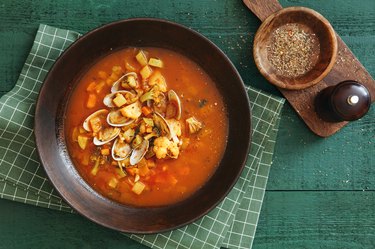
Broth soups work well as hot-weather meals in part because they're light and refreshing, and in equal part because—when served hot—they help you sweat, which in turn cools you by evaporation. Some soups lean into this phenomenon by cranking up the spicy heat to help promote additional perspiration. Others are served chilled to help cool you directly (December's leek and potato soup can be July's chilled vichyssoise, for example). Just remember that you'll need a heavier hand with seasonings if you plan to serve soup chilled. Heat expands and enlarges flavors, while chilling minimizes them.
Part 5: Soup Pairings
Sometimes soup is the meal, and sometimes it's just a part of the meal. Either way, you'll get more mileage from your soup making if you pair up your soups with appropriate accompaniments.
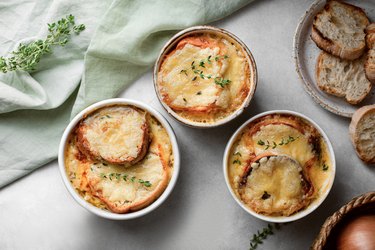
1. Bread
The default soup pairing in many cultures is bread in its numerous iterations. It might come in the form of a hunk of crusty bread, a soft dinner roll or even a handful of crumbled crackers—they all count. So do the tortillas in a bowl of tortilla soup and naan or roti paratha eaten with dhal or kadhi. Dumplings fall into this category too.
2. Traditional garnishes
Some soups come with a traditional set of garnishes that you can simply adopt. If you're serving pho, for example, set out a plate full of fresh herbs (Thai basil, mint, cilantro) as well as thin-sliced chilies, bean sprouts and lime wedges to squeeze over the bowl. In other cases, appropriate accompaniments suggest themselves quickly with a bit of forethought. If you already have a pot of plain potato soup, adding shredded cheddar, a spoonful of sour cream, bacon bits and chives to each bowl will turn it into "loaded baked potato soup." Similarly, you could add a swirl of coconut milk to Thai pumpkin soup or sour cream to your squash and ginger soup. Toasted pumpkin seeds would be a suitable garnish for either one.
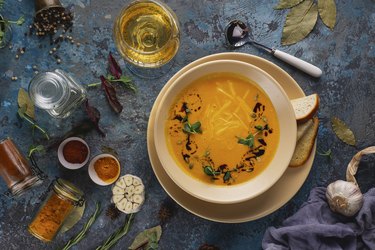
3. Beverages
Red wine or beer is an appropriate pairing for most hearty soups and stews made with red meat. Beer also works with anything spicy. Spicy foods are tougher to match with wine, but a Gewürztraminer or an off-dry Riesling will usually work. Light, summery spritzers, coolers and fruity sangria work well with equally light and summery soups. Dry whites are also a good pairing for most of the same soups and especially for any soup containing seafood.
The Bottom Line...
When it comes to soup, your personal preferences form the best guide. Consider which flavors you like together and how much "heft" you want to add to each meal. Guides like ours can help establish the groundwork, but your taste buds will ultimately lead the way.